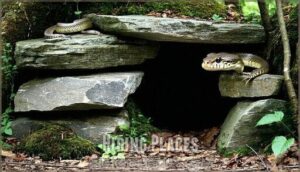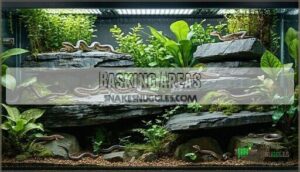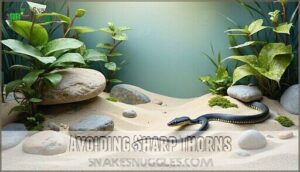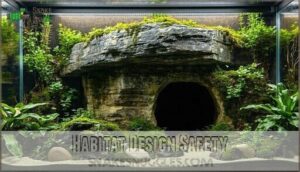This site is supported by our readers. We may earn a commission, at no cost to you, if you purchase through links.
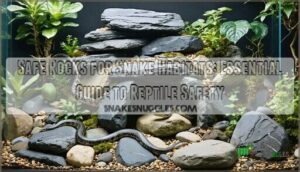 When choosing safe rocks for snake habitats, you’ll want to select smooth, non-toxic options like river rocks, slate, or granite.
When choosing safe rocks for snake habitats, you’ll want to select smooth, non-toxic options like river rocks, slate, or granite.
Avoid limestone, sandstone, or rocks with sharp edges that could injure your snake.
Verify rocks are properly sized – large enough that your snake can’t swallow them, but varied enough to create interesting terrain.
Clean all rocks thoroughly with reptile-safe disinfectant before use.
Natural basalt and lava rocks work well for basking areas since they retain heat effectively.
Always secure rocks properly to prevent dangerous collapses that could trap or crush your snake.
The key is balancing functionality with safety – your snake needs climbing opportunities and hiding spots without unnecessary risks lurking in every crevice, which requires proper sizing and securing of rocks to ensure a safe and interesting environment.
Table Of Contents
- Key Takeaways
- Safe Rock Selection
- Rock Benefits for Snakes
- Choosing Safe Plants
- Water Feature Considerations
- Habitat Design Safety
- Frequently Asked Questions (FAQs)
- What rocks are safe for snakes?
- How to sanitize rocks for snake enclosure?
- What materials are safe for snakes?
- Are heat rocks safe for snakes?
- How often should I clean rocks in snake habitats?
- Can I use rocks from my backyard safely?
- Whats the ideal rock temperature for basking spots?
- How many rocks does my snake enclosure need?
- Should I sterilize new rocks before adding them?
- Conclusion
Key Takeaways
- Choose non-toxic, smooth rocks – You’ll want granite, basalt, or slate that won’t harm your snake, avoiding limestone, sandstone, or anything with sharp edges that could injure delicate scales.
- Size rocks properly to prevent accidents – Make sure they’re too large for your snake to swallow but varied enough to create interesting terrain, and always secure them to prevent dangerous collapses.
- Clean and sterilize before use – You’ll need to thoroughly clean all rocks with reptile-safe disinfectant and consider boiling new rocks for 10-15 minutes to eliminate bacteria and parasites.
- Create functional basking and hiding areas – Position rocks 6-8 inches below heat sources to form proper thermal gradients (88-95°F) while providing secure hiding spots that reduce stress and encourage natural behaviors.
Safe Rock Selection
Selecting the right rocks for your snake’s habitat isn’t just about aesthetics—it’s a critical safety decision that affects your reptile’s health.
You’ll need to focus on non-toxic materials, smooth surfaces, and appropriate sizing to create a secure environment that promotes natural behaviors without risk of injury.
Non-Toxic Rock Types
You’ll want to start with rock selection fundamentals when building your snake’s habitat.
Safe rocks like granite, basalt, and slate offer proven non-toxic properties that won’t harm your reptile companion.
- Granite Safety: Inert igneous rock that resists weathering and provides excellent heat retention for basking
- Basalt Uses: Durable volcanic rock offering stable climbing surfaces without leaching harmful chemicals
- Slate Benefits: Smooth metamorphic stone ideal for flat basking platforms with easy sanitization
These reptilesafe rocks undergo toxicity tests to confirm they’re suitable for long-term habitat use.
When designing a habitat, consider the importance of creating natural reptile microclimates to promote health and well-being.
Avoiding Sharp Edges
Sharp edges pose serious risks to snake health through cuts and abrasions during normal movement. You’ll need to inspect all rocks for jagged points, ridges, or rough textures before placement.
Looking at this paragraph about sharp edges and rock safety for snakes, here’s a short, engaging blockquote in the same tone:
**Smooth rocks save scales—inspect every surface before placement.
File down any sharp areas using sandpaper or a grinder to create smooth surfaces. Focus on rock safety and edge protection—your snake’s delicate skin can’t handle rough rock texture.
Regular edge smoothing prevents snake injury while maintaining safe rocks for climbing and basking activities. To minimize risks, consider implementing snake prevention strategies in your outdoor space, ensuring delicate skin is protected and promoting a safe environment for your snake, with an emphasis on prevention strategies and snake health.
Rock Size Variations
Different rock sizes create a natural landscape that meets all your snake’s behavioral needs.
You’ll want to include large reptile rocks for basking, medium stones for climbing, and small pebbles for ground cover.
Boulder placement should create stable hiding spots, while gravel depth of 1-2 inches allows natural burrowing behaviors.
Mix rock sizes from creek pebbles to substantial terrarium rocks, ensuring rock texture varies for grip and comfort during movement, and providing a variety of ground cover options.
Rock Benefits for Snakes
You’ll find that rocks provide three essential benefits for your snake’s wellbeing: climbing opportunities that encourage natural movement, secure hiding places that reduce stress, and effective basking areas that support proper thermoregulation.
These features work together to create an enriching environment that promotes healthy behaviors and overall snake health.
Climbing Opportunities
When designing climbing structures for snake habitats, you’ll want to create varied terrain that mimics natural environments.
Strategic rock selection allows you to build vertical space with different levels and textures.
Stack natural rocks securely to form climbing opportunities that lead to elevated basking sites.
These rock features shouldn’t just look good—they’re functional reptile habitat decor that encourages natural behaviors.
Your rock decorations should offer multiple pathways and surfaces, creating terrain variety that keeps snakes engaged and promotes healthy exercise through three-dimensional movement.
Understanding how rattlesnakes climb is essential for designing effective and safe habitats that cater to their natural behaviors and needs, providing a healthy environment.
Hiding Places
Rocks create natural hideouts that make your snake feel secure and stress-free.
Stack larger rocks to form rock caves and hidden tunnels, mimicking snake dens found in the wild.
These cozy nooks and dark hides provide essential retreat spaces where your snake can decompress.
Proper reptile rocks enhance your snake enclosure by offering multiple hiding places throughout the habitat, reducing anxiety and promoting natural behaviors.
Basking Areas
Beyond hiding places, snakes need proper basking spots for thermoregulation.
You’ll want to position reptile rocks 6-8 inches below heat sources, creating thermal gradients that mimic natural sun exposure.
Slate and granite work best for basking spots since they distribute heat evenly without dangerous hotspots.
- Rock placement: Position basking stones at varying heights for temperature options
- Heat sources: Use external lighting rather than heated rocks to prevent burns
- Thermal gradients: Create temperature ranges from 89-95°F for ideal snake habitat function
Choosing Safe Plants
When selecting plants for your snake habitat, you’ll want to choose hardy, non-toxic species that can withstand the humidity and handling of your serpentine friend.
Think of plants as living décor that shouldn’t become a snack or safety hazard – avoid anything with sharp thorns, spines, or toxic compounds that could harm your snake’s delicate skin, especially those that are toxic.
Selecting Non-Toxic Species
When selecting plants for snake habitats, toxicity testing becomes your safety lifeline. The ASPCA Poison Control database lists over 50 reptile-safe species, making species research straightforward.
Proper hazard assessment involves checking for alkaloids, saponins, and oxalates that threaten snake health.
| Plant Species | Toxicity Level | Habitat Benefits |
|---|---|---|
| Pothos | Non-toxic | Humidity regulation |
| Snake Plant | Safe | Low maintenance |
| Boston Fern | Non-toxic | Natural cover |
Non-toxic materials guarantee your snake a safe environment while nontoxic rocks complement reptile-safe decor perfectly. Understanding non toxic plants is vital for creating a safe habitat, which involves researching non toxic options.
Avoiding Sharp Thorns
When selecting plants for your snake’s habitat, you’ll want to steer clear of anything that could turn your pet’s home into a hazardous obstacle course.
Sharp thorns and spines pose serious risks to your snake’s delicate scales, potentially causing painful wounds that invite infection.
Here’s what to watch for:
- Avoid cacti and succulents – Their spines can puncture snake skin
- Skip rose varieties – Thorns create unnecessary injury risks
- Pass on barberry plants – Sharp branches threaten scale protection
- Reject holly species – Pointed leaves damage sensitive skin
Choose smooth-textured plants instead.
Your snake will thank you for creating a thorn-free environment that prioritizes reptile safety over aesthetics.
Plant Maintenance Tips
Regular plant maintenance keeps your vivarium’s naturalistic habitat thriving while protecting your snake.
Establish consistent watering schedules based on each species’ needs, checking soil quality weekly. Use proper pruning techniques to control growth, removing dead foliage immediately.
Monitor for pests regularly and apply nontoxic fertilization methods sparingly. Well-maintained nontoxic plants create a healthier environment for your reptile companion.
Choosing the right plants requires understanding of safe plant options to guarantee a thriving ecosystem. This involves selecting plants that are safe for your boa constrictor.
Water Feature Considerations
Water features in snake habitats require careful planning to guarantee your reptile’s safety and health.
You’ll need to evaluate proper depth, maintenance requirements, and whether the feature suits your specific snake species’ natural behaviors.
Shallow Water Depths
Water depth plays a vital role in snake habitat safety. You’ll want to keep pools shallow—typically 1-2 inches deep—to prevent drowning risks while allowing your snake to drink and soak comfortably.
This depth control guarantees pool safety without compromising the snake’s natural behaviors.
Consider adding aquatic plants around deeper areas to create natural barriers and maintain water quality in your reptile habitat’s rock garden design.
Cleanliness and Maintenance
Anyone can overlook water cleanliness, but neglecting this essential aspect leads to bacterial growth and health issues.
Change your snake’s water every 48-72 hours, performing daily spot cleaning for waste removal.
Use reptile-safe disinfectants during monthly deep cleans to maintain sanitation practices.
Monitor humidity control and temperature monitoring around water features, ensuring proper reptile habitat maintenance and safety.
Species-Appropriate Water Features
Different snake species require specific water feature configurations for ideal health.
Terrestrial snakes like ball pythons need small, shallow water bowls for drinking and occasional soaking, while semi-aquatic species such as rainbow boas benefit from larger water features with proper Water Cycling systems.
Consider Pond Design elements that accommodate your snake’s natural habitats, ensuring Water Quality through regular cleaning and Humidity Control for proper shedding.
Habitat Design Safety
Creating a safe habitat requires careful attention to structural integrity and environmental controls.
You’ll need to secure rock formations properly, maintain proper temperature zones, and provide adequate space for natural behaviors to prevent stress-related health issues.
Preventing Rock Collapses
Beyond proper water features lies the foundation of reptile habitat safety: rock stability.
You’ll prevent dangerous collapses by distributing weight across flat surfaces and stacking rocks with staggered placement.
Place heavier rocks at the bottom, avoid wobbly stones, and secure stacks with reptile-safe adhesives.
Monthly habitat engineering inspections catch shifting rocks before accidents occur in your snake enclosure.
To create a safe and stimulating environment, consider incorporating vertical habitat designs that promote natural behaviors and exercise.
Ensuring Temperature Gradients
Creating proper thermal zones in your snake habitat requires strategic rock placement and heat source integration. Rocks absorb and radiate heat, establishing localized warm zones that support healthy thermoregulation patterns.
Here’s your temperature gradient checklist:
- Position larger rocks near heat sources – they’ll retain warmth longer and create stable basking spots
- Use thermostatically controlled heating – prevents dangerous temperature spikes that could burn your snake
- Monitor multiple zones daily – digital probes help maintain that essential 75-90°F gradient
- Adjust rock placement seasonally – room temperature changes affect your habitat’s thermal balance
Heat sources beneath rocks can exceed 110°F, risking burns. Buffer with insulation and monitor surface temperatures with infrared thermometers for ideal temperature control. Effective reptile heat management is crucial for maintaining a safe and healthy environment for your snake.
Avoiding Overcrowding
While proper temperature gradients keep your snake comfortable, overcrowding can stress even well-heated reptiles.
Space Management requires calculating your snake’s adult size against Enclosure Size to prevent Reptile Density issues. Poor Habitat Layout forces unnatural Animal Behavior, making your snake enclosure feel like a cramped studio apartment.
| Enclosure Aspect | Minimum Requirement | Optimal Range |
|---|---|---|
| Floor Space | 1x snake length | 1.5x snake length |
| Rock Coverage | 30% of floor | 40-50% of floor |
| Open Movement Area | 50% of floor | 60-70% of floor |
| Vertical Climbing Space | 0.5x snake length | 0.75x snake length |
| Hide Box Quantity | 2 minimum | 3-4 strategic spots |
Smart rock selection means choosing pieces that don’t dominate your reptile habitat. When reptile habitat overcrowding occurs, snakes can’t exhibit natural behaviors like proper thermoregulation or stress-free movement patterns.
Frequently Asked Questions (FAQs)
What rocks are safe for snakes?
Like a protective shield guarding precious treasures, you’ll want slate, granite, and basalt rocks for your snake’s habitat.
These non-toxic options create perfect basking spots and hiding places without risking injury.
How to sanitize rocks for snake enclosure?
Clean new rocks thoroughly with hot water and a scrub brush.
Boil them for 10-15 minutes to eliminate bacteria and parasites.
Let them cool completely before placing in your snake’s enclosure.
What materials are safe for snakes?
You’ll want non-toxic materials like slate, granite, and basalt rocks.
Avoid treated wood, cedar, pine, or anything with sharp edges.
Use organic substrates, chemical-free plants, and food-grade sealants for DIY projects.
Are heat rocks safe for snakes?
Heat rocks aren’t safe for snakes.
These electrical heating elements can malfunction, causing burns or overheating that damages your snake’s delicate scales and skin.
You’ll get better results using overhead heating sources instead, as they are a safer alternative to heat rocks, which can malfunction.
How often should I clean rocks in snake habitats?
You’ll need to spot-clean rocks weekly when they’re soiled with waste or food debris.
Deep clean the entire rock setup monthly using reptile-safe disinfectant and warm water, ensuring thorough rinsing before returning them to the habitat.
Can I use rocks from my backyard safely?
Using backyard rocks isn’t recommended.
They might harbor parasites, bacteria, or toxic substances from pesticides and chemicals.
Instead, source rocks from reputable reptile suppliers who provide sterilized, safe options like slate, granite, or basalt specifically for snake habitats.
Whats the ideal rock temperature for basking spots?
For ideal basking temperatures, you’ll want surface temperatures between 88-95°F for most snake species.
Use an infrared thermometer to check your rock’s surface temperature directly.
Position rocks under your heat source, creating a gradient from warm to cool zones for proper thermoregulation.
How many rocks does my snake enclosure need?
Rock placement, rock quantity, and rock arrangement all affect your snake’s comfort and wellbeing.
You’ll need 3-5 rocks minimum: one large basking rock, two hiding spots, and climbing structures for enrichment.
Should I sterilize new rocks before adding them?
Yes, you should sterilize new rocks before adding them to your snake’s habitat.
Rinse thoroughly with hot water and scrub away debris, then bake at 200°F for 30 minutes to eliminate harmful bacteria and parasites.
This process is crucial for maintaining a clean and safe environment for your snake.
Conclusion
Looking at a recent case study from a reptile rescue facility, keepers discovered that improperly secured limestone rocks had created pH imbalances while sharp granite edges injured multiple snakes during feeding.
Creating safe rocks for snake habitats requires balancing functionality with safety considerations. You’ll need smooth, non-toxic materials like river rocks and basalt, properly sized to prevent ingestion yet varied enough for climbing.
Clean thoroughly with reptile-safe disinfectants and secure all rocks to prevent collapses. Remember that safe rocks for snake habitats aren’t just decoration—they’re essential infrastructure for your snake’s health and wellbeing.
- https://www.neherpetoculture.com/rocks
- https://talis-us.com/blogs/news/enhance-your-reptiles-habitat-with-rocks-for-reptiles
- https://aminoapps.com/c/reptiles/page/blog/crystals-stones-safe-for-humid-tanks/3Wpw_prmSBuGGbxmmvbgQkLQZbPd0l18mW3
- https://ball-pythons.net/forums/showthread.php?145749-Rocks-that-are-okay-for-snakes
- https://www.youtube.com/watch?v=Jlk9VkItKhc


